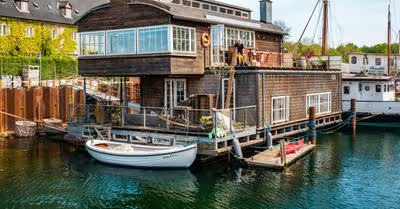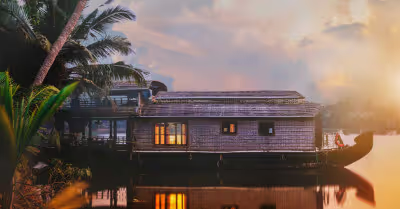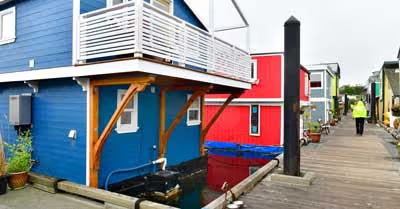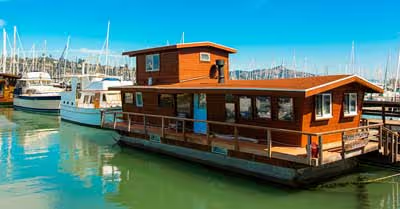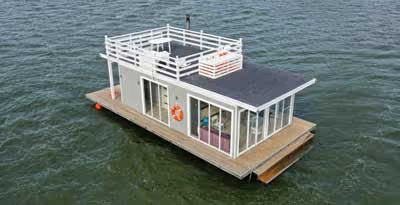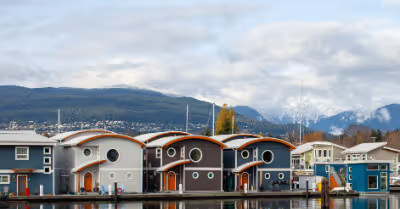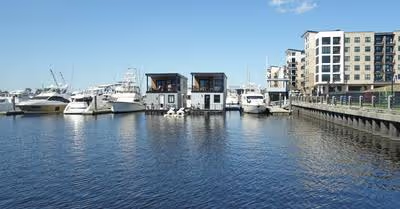
When you're not using your houseboat, it's usually a good idea to dock it at a marina. But do marinas even allow houseboats?
Yes, marinas do allow houseboats, but the rules and regulations regarding houseboats and where they are allowed to be anchored or moored can be confusing – especially considering rules and regulations that are put together by private entities as in, owners of marinas.
It goes without saying that one needs to know all the rules and regulations of a particular marina, harbor, or lake that they will be using to dock their houseboat. One of the reasons for that is every state or local governing body tends to enact their own regulations regarding houseboats and what is or isn't permitted.
If you've been wondering the same thing, the good news is that you're in the hands of the experts now. We'll tell you all about the murky world of houseboats, marinas, and where you can dock your houseboat.
Houseboats vs. Liveaboards – Does it Matter to Marinas?
In case you were wondering - yes, there is technically a difference between the two, depending on which state you live in, and - yes, it does matter to marinas. To get a good idea of the rules and regulations regarding houseboats, you will have to know the differentiating factors between the two and why they even exist in some states.
A Quick History
With the inflow of shipbuilders during WWII, the number of houseboats and liveaboard boats exploded, especially along the San Francisco waterfront and along the Richardson Bay shoreline in southern Marin County. After the war, many folks who had been drawn to Sausalito migrated to the houseboat community, creating houseboats that resembled wooden sculptures more than residences.
Houseboats had mostly consolidated in the Waldo Point region in Richardson Bay by the 1960s; however, a handful might be found in other sections of the Bay. On the other hand, the liveaboard boat communities are not as dense as the Bay houseboat villages. The majority of liveaboard boats are moored at one of the Bay's several recreational marinas; however, others are tied outside of a marina.
Houseboat vs. Live-Aboard
The terms "houseboat" and "liveaboard boat" conjure up mental images of the object's form and function based on personal experience. A houseboat, for example, is a recreational vessel used for active recreational navigation as well as vacation dwelling. A houseboat is a floating dwelling anchored to a pier but not utilized for navigation.
To a boater, a liveaboard boat is any vessel with living quarters (sleeping, cooking, bathroom, and washing facilities) on which people spend a weekend working on the vessel or a two-week summer vacation traveling from one place to another. However, liveaboard boats can also be utilized as a person's primary house and are only used for active navigation on rare occasions.
But because liveaboard boats may also be used as a person's primary habitation and are only utilized for active navigation on occasion, there is an obvious distinction between a houseboat and a liveaboard boat. A "houseboat" is a moored boat or building not utilized for active navigation and is used for private residential or other non-water-oriented purposes.
A "liveaboard boat" is a vessel that is utilized or capable of being used for active self-propelled navigation and that is moored for an extended length of time and used as a private primary dwelling during that time.
What Marinas Call Houseboats
The majority of boats are built to allow for active self-propelled navigation and living onboard. Boats longer than 22 feet usually have enough space for dining, sleeping, and washing. Houseboats are lived on when traveling from one point to another, whether it's a weekend sailing competition in the Bay or a coastal voyage from Seattle to San Diego with a stop in San Francisco Bay for sightseeing, rest, or repair, maintenance, and resupply. However, some houseboats are tied at marinas and used for navigation and long-term private dwellings.
Liveaboard boats are often sailboats, although they may also be power vessels like cabin cruisers, former fishing boats, and tugboats. The most typical length of sailboat utilized as a liveaboard vessel is 27 to 36 feet. Larger boats, 40 to 50 feet long with 250 to 300 square feet of living space, have recently become popular.
A living-dining space, two bedrooms (staterooms), a kitchen (galley), a bathroom (head), running water, and power are all frequent features aboard larger boats. Smaller liveaboard boats offer less living space, including a kitchen, dining, living, and sleeping area, as well as a bathroom.
Costs of Owning Docking a Houseboat
Boat owners typically pay an additional rental charge in addition to the cost of the boat. Owners of liveaboard boats pay the usual berth rental depending on the size of the boat and an extra fee for enhanced use of the marina services. The extra costs might range from $7.50 per foot per month to $7.50 per foot per month. Thus, berth leasing for a 40-foot liveaboard yacht might cost upwards of $300 per month.
In some areas, houseboats and certain liveaboard boats are examples of fill. The McAteer-Petris Act expressly mentions houseboats as a type of floating fill. When other vessels, such as liveaboard boats, are "moored for lengthy periods" in the Bay, they are considered fill.
Using a Marina; Rules and Regulations
Municipal rules abound in California, particularly in coastal communities, from San Diego to San Jose to San Francisco. These rules include, no vessel shall be tied, anchored, grounded, parked, or otherwise positioned in any canal for more than 96 hours unless otherwise allowed.
It also states that both may only be moored at a permitted marina to the extent permitted by law, and only if the vessel is moored in accordance with all applicable marina permit conditions as well as applicable federal and state laws, such as having a sanitation device and self-propelled navigation. It's the same if you're anchored at an approved dock.
In Oklahoma, the Department of Public Safety oversees boating rules but does not currently impose liveaboard restrictions in state waterways. However, municipal governments can control their waters. The Grand River Dam Authority regulates the use of Lake O' the Cherokees, often known as Grand Lake. For example, it permits free anchoring with permission, but for hygienic reasons, mooring cannot last more than 48 hours in any one site.
Docking at a Marina
Every mile, there are numbered red and green buoys that you may follow using the chart that came with your houseboat rental. Boaters use these buoys as navigational and informational aids. Because the water level changes daily and periodically, sticking between the buoys is the safest method to traverse the lake, as it avoids underwater obstructions that may not be apparent from the boat. However, keep a watchful eye on the main channel between the buoys since there may be submerged impediments there as well. You can also use binoculars to let you see the buoys more clearly.
Houseboats are usually moored at a marina or at a private dock, depending on where you live and what you have access to. Owners of houseboats will have to pay a monthly charge to moor their vessels at a marina; therefore, a private spot is preferable because no payment is necessary.
Marinas not only include docks for houseboats, but they also have docks or moorings for small boats or complex yachts. Marinas typically provide additional services like fuel, water, and sewage disposal. Larger marinas may also offer washing facilities, and some may even have grocery shops or at least a limited selection of food for sale in general store sections. Although the services provided by each marina differ, if you are seeking to buy a houseboat, these services might be a determining factor in which marina you choose to park your houseboat at.



